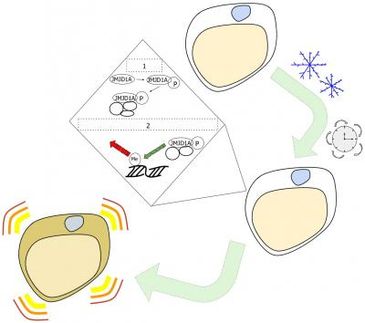Plants and stress: key players on the thin line between life and death revealed
Advertisement
Our crops are not doing well these days: too much water, too little sunlight... In short, they are suffering from stress. Scientists from VIB, associated with the Katholieke Universiteit Leuven (K.U.Leuven), have revealed a new mechanism demonstrating the intricate ways in which plants deal with stress. The newly discovered control system has a remarkable way of orchestrating the activity of hundreds of genes, forcing the plant into 'safety mode;' the consumption of energy is contained while the organism is stimulated to mobilize reserves. This may have a negative impact on growth, but it allows the plant to temporarily safeguard itself against pernicious stress conditions. These findings also may prove to be useful beyond the case of plants, for the results are likely to be valuable in understanding disorders such as cancer and diabetes.
Plants have developed different mechanisms to detect and cope with 'stress.' Together with his American colleagues at Harvard Medical School, VIB scientist Filip Rolland, associated with the Katholieke Universiteit Leuven, is uncovering a new system of detection and control. It is driven by KIN10 and KIN11. These 'kinases' - which are also found in human beings - react to energy shortages, when, for example, there is too little sunlight or too little sugar production. They control the activity of a broad network of genes, promoting the release of energy (catabolism) from alternative sources and blocking its assimilation (anabolism). In this way, the plant protects itself against stress conditions; like a really bad summer.
The model organism for this study was Arabidopsis thaliana or thale cress. The scientists have tested numerous stress conditions that affect photosynthesis and energy production, such as darkness, herbicide treatment and flooding (lack of oxygen). By overexpressing the KIN10 gene, causing the plant to produce more of this protein, stress tolerance is increased and plants survive longer. By switching off these genes, their control function is eliminated.
With this research, the Flemish and American scientists have succeeded for the first time in attributing KIN10 and KIN11 a key role in the control of the plant energy budget and metabolism and thus the fragile balance between growth and survival; in short, the choice between life and death.
The new insights gained by this study are not limited to the functioning of plants; they may also be important for human beings. KIN10 and KIN11, as 'fuel gauges' controlling the expression of a whole set of genes, are also found in mammals. The results with plants, therefore, may play a pioneering role in discovering new functions of these proteins in disorders such as diabetes, cancer, obesitas, and aging.
Original publication: Baena-González et al., "A central integrator of transcription networks in plant stress and energy signalling", Nature, 2007























































